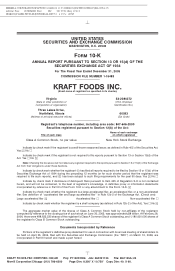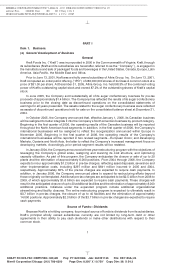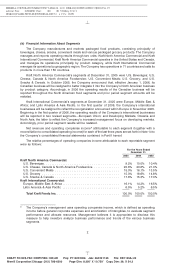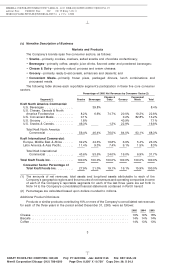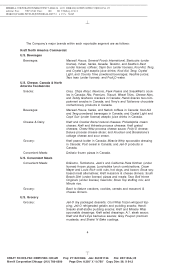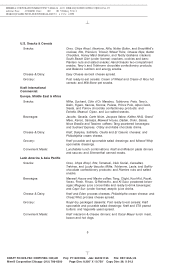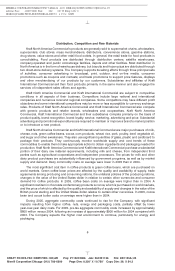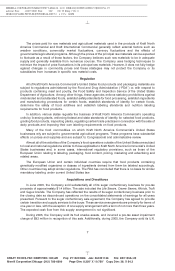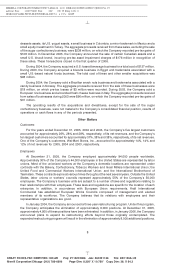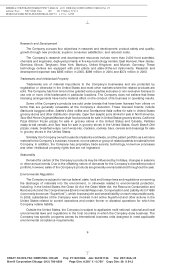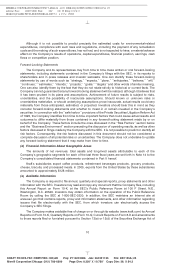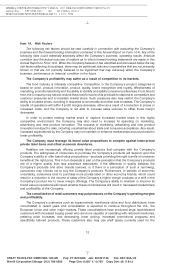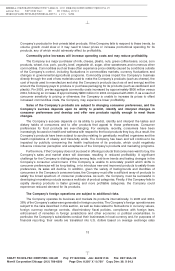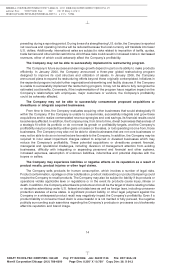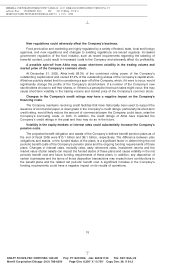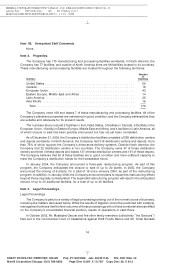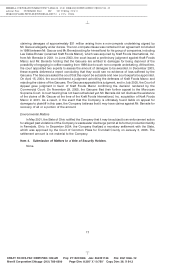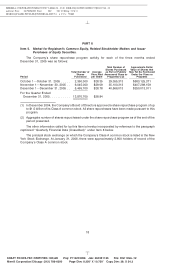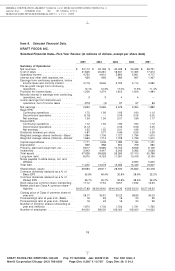Kraft 2005 Annual Report Download - page 10
Download and view the complete annual report
Please find page 10 of the 2005 Kraft annual report below. You can navigate through the pages in the report by either clicking on the pages listed below, or by using the keyword search tool below to find specific information within the annual report.
MERRILL CORPORATION MBLOUNT// 9-MAR-06 14:03 DISK126:[06CHI5.06CHI1135]DE1135A.;25
mrll.fmt Free: 50D*/300D Foot: 0D/ 0D VJ RSeq: 9 Clr: 0
DISK024:[PAGER.PSTYLES]UNIVERSAL.BST;51
KRAFT FOODS-FSC CERTIFIED-10K/AR Proj: P1102CHI06 Job: 06CHI1135 File: DE1135A.;25
Merrill Corporation/Chicago (312) 786-6300 Page Dim: 8.250 X 10.750Copy Dim: 38. X 54.3
Research and Development
The Company pursues four objectives in research and development: product safety and quality;
growth through new products; superior consumer satisfaction; and reduced costs.
The Company’s research and development resources include more than 2,000 food scientists,
chemists and engineers, deployed primarily in five key technology centers: East Hanover, New Jersey;
Glenview, Illinois; Tarrytown, New York; Banbury, United Kingdom; and Munich, Germany. These
technology centers are equipped with pilot plants and state-of-the-art instruments. Research and
development expense was $385 million in 2005, $388 million in 2004 and $374 million in 2003.
Trademarks and Intellectual Property
Trademarks are of material importance to the Company’s businesses and are protected by
registration or otherwise in the United States and most other markets where the related products are
sold. The Company has from time to time granted various parties exclusive or non-exclusive licenses to
use one or more of its trademarks in particular locations. The Company does not believe that these
licensing arrangements have had a material effect on the conduct of its business or operating results.
Some of the Company’s products are sold under brands that have been licensed from others on
terms that are generally renewable at the Company’s discretion. These licensed brands include
Starbucks bagged coffee, Seattle’s Best coffee and Torrefazione Italia coffee for sale in United States
grocery stores and other distribution channels, Capri Sun aseptic juice drinks for sale in North America,
Taco Bell Home Originals Mexican style food products for sale in United States grocery stores, California
Pizza Kitchen frozen pizzas for sale in grocery stores in the United States and Canada, Pebbles
ready-to-eat cereals, and Tazo teas for sale in grocery stores in the United States, South Beach Diet
pizzas, meals, breakfast wraps, lunch wrap kits, crackers, cookies, bars, cereals and dressings for sale
in grocery stores in the United States.
Similarly, the Company owns thousands of patents worldwide, and the patent portfolio as a whole is
material to the Company’s business; however, no one patent or group of related patents is material to the
Company. In addition, the Company has proprietary trade secrets, technology, know-how processes
and other intellectual property rights that are not registered.
Seasonality
Demand for certain of the Company’s products may be influenced by holidays, changes in seasons
or other annual events. Due to the offsetting nature of demands for the Company’s diversified product
portfolio, however, sales of the Company’s products are generally evenly balanced throughout the year.
Environmental Regulation
The Company is subject to various federal, state, local and foreign laws and regulations concerning
the discharge of materials into the environment, or otherwise related to environmental protection,
including, in the United States, the Clean Air Act, the Clean Water Act, the Resource Conservation and
Recovery Act and the Comprehensive Environmental Response, Compensation and Liability Act of 1980
(commonly known as ‘‘Superfund’’), which imposes joint and several liability on each responsible party.
In 2005, subsidiaries of the Company were involved in 94 active Superfund and other actions in the
United States related to current operations and certain former or divested operations for which the
Company retains liability.
Outside the United States, the Company is subject to applicable multi-national, national and local
environmental laws and regulations in the host countries in which the Company does business. The
Company has specific programs across its international business units designed to meet applicable
environmental compliance requirements.
9
6 C Cs: 61739

